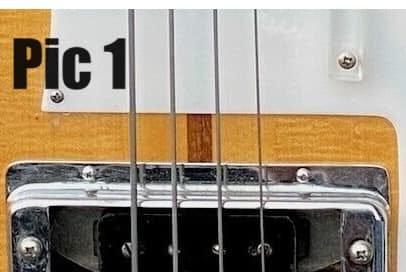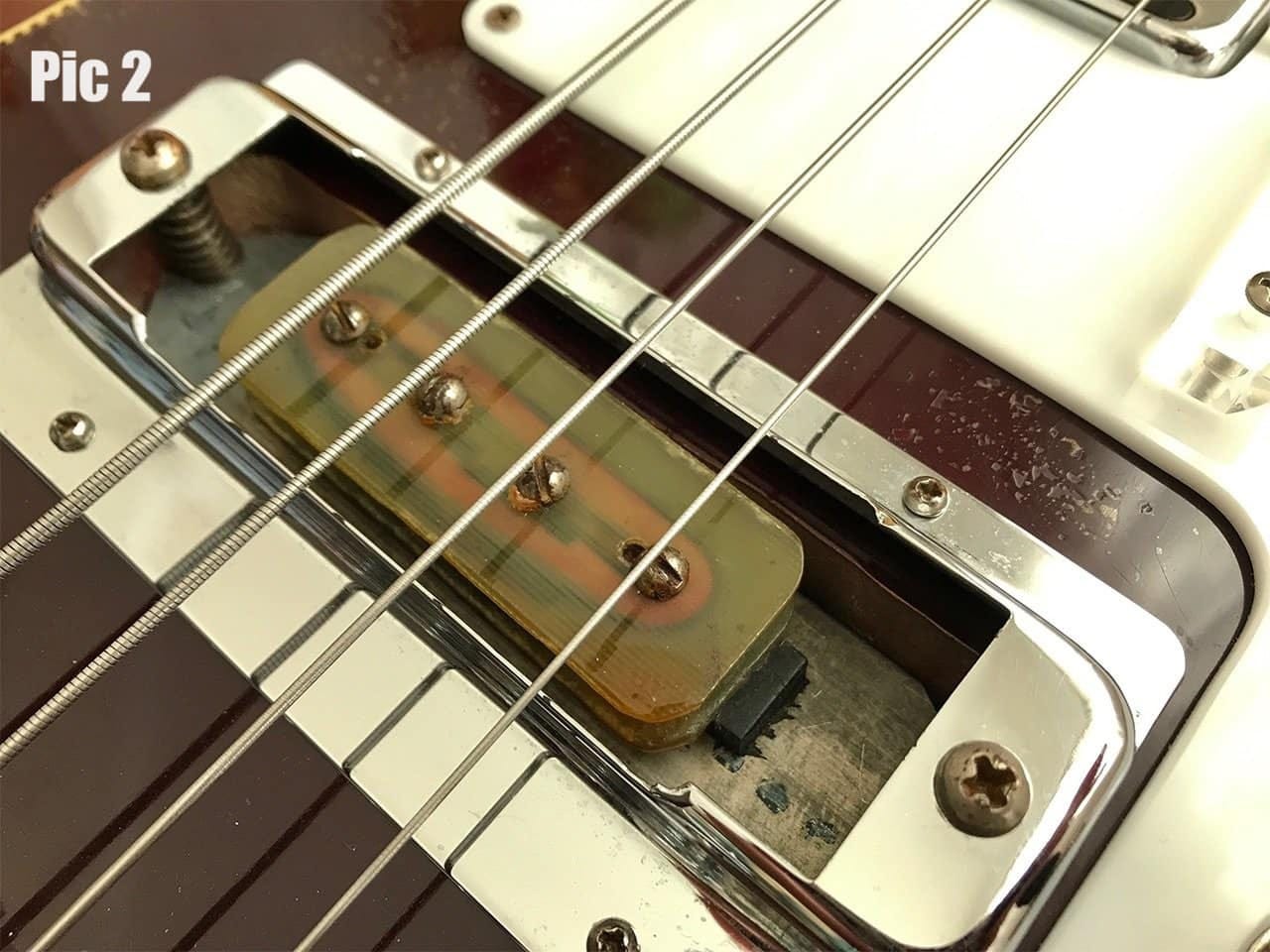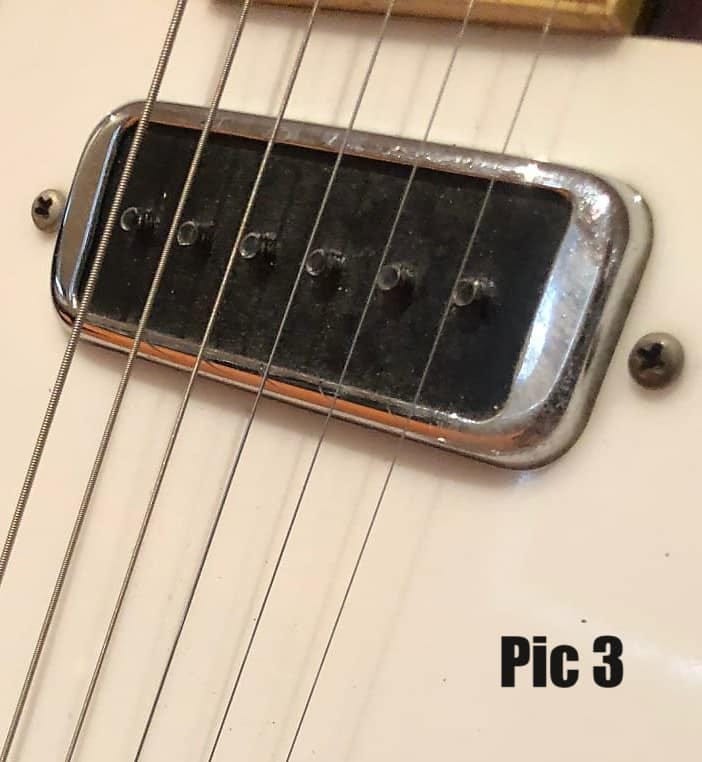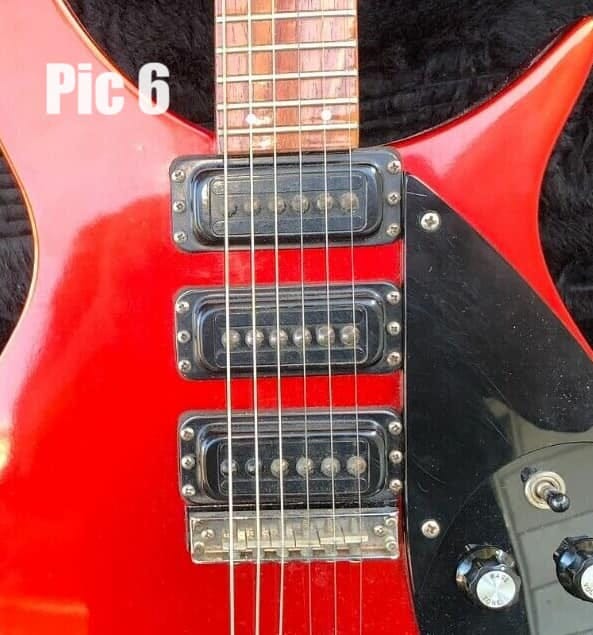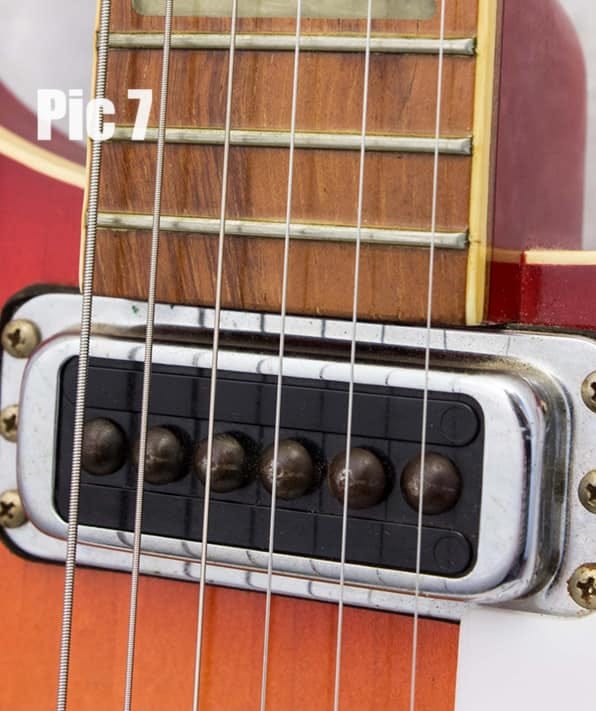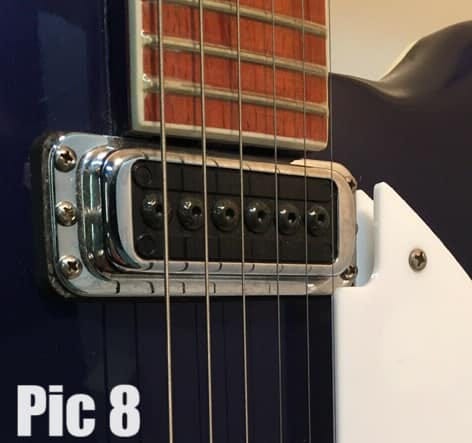The Higain pickup first appeared on the 4000 series basses in late 1968 in the bridge position, replacing the venerable 1930’s vintage horseshoe design. Unlike the horseshoe pickup with its magnets that surrounded the coil or the toaster pickup with its magnetic polepieces, the magnet on all Higain pickups is a rubberized magnet under the pickup that the polepieces come into contact with to create an electromagnetic field for each string. The “first” Higain-equipped bass I could find on the Rickenbacker Register is from October, 1968, but there are Oct/Nov/Dec examples wearing both Higains and horseshoes. By 1969, though, the transition appears to be complete.
But remember: when it comes to Rickenbacker, never say never. Are there 69’s with horseshoes? Absolutely. Let’s just say that by 1969 STANDARD production had shifted to Higains. The same caveat applies to all changes that follow in this post!
These first Higains had slotted polepieces, but they were NOT designed to be adjusted. Doing so could in fact damage the pickup. Subsequent iterations removed the slots to avoid this possibility. The bobbin was a white or pale green “G-10 mil spec glass filled epoxy printed circuit board material” (per John Hall). It started life unpainted, but by the end of its run gained a coat of black paint. Because of the slight pattern in the material the manufacturing process creates, many people refer to these bobbins as “fiberboard” because once painted, they…kinda look like fiberboard. Pic 1 below shows this pickup with paint, Pic 2 shows what it looks like without the paint.
The guitar version of the Higain was introduced in 1969 on the 381. While the 1968 prototypes and January 1969 production 381s had toaster pickups, starting in February of 1969 the Higains appear to have become standard issue. Labeled “Pic 3” below, it seems Rickenbacker learned their lesson from the bass pickup and eliminated the possibility of screw related damage by removing the screw head and leaving the polepieces as simple threaded stock.
These pickups are often referred to as “transitional” or “first gen” Higains. While I said we’re not going to go into technical specs in this post, know that these pickups are actually less “hot” than toasters of the time or the Higains you’re probably most familiar with, and have their own, unique sound.
1970-74 was a bit of a mess, pickup wise at the Rickenbacker factory. The first-gen Higains began appearing on other guitars during 1970, but not exclusively in most cases. For example, you can find 1970 360’s both with toasters and first gen Higains—but there’s no clear cutover date, and you can find guitars with toasters made after the Higains entered production. Some models—like the aforementioned 381 and the 331 Lightshow—appear to have worn first-gen Higains as standard throughout their entire runs…but that doesn’t mean there aren’t 381’s made after early 69 with toasters. Suffice it to say 1970 began the overall transition from toasters to Higains. But it would take a couple of years for things to settle down.
1971 continued the general transition from toasters to Higains on guitars. All basses wore the screw-top Higain in the bridge position, but continued to wear toasters at the neck. Most guitar models began moving to the first gen Higains, although again you do find toasters throughout the year—with the notable exception of the 420/450/460 series guitars, which would be the last guitars to phase out toasters in 1974. In fact, it’s safe to say those were the only guitars in production at that time to never wear first gen Higains.
The 480 series wore first gens when launched in 1972, and is one of the few guitars (along with the 331) to never wear toasters as standard. There were very few guitars apart from 480s built in 72, but the ones that exist again wore a mix of first gen Higains and toasters. In early 1973, however, the basses would get the first revised Higain pickup in the bridge position: the button top.
On button top Higains, the screw top polepieces were replaced with black painted, button top drive screw polepieces. They were hotter than the pickups they replaced as well. Button top guitar Higains would follow in April/May of 73–wound hotter, with the threaded polepieces replaced by the same black painted drive screw polepieces as found on the bass pickup. Both versions used the same black painted bobbins as the earlier pups.
Labeled “Pic 4” below, these are the Higains you probably think of when you hear the “Higain sound”. All the versions that followed were evolutions from this pickup. A neck Higain appeared on the 4001 in September of 73 and in early 74 toasters finally disappeared from the 400 series guitars, making the button top Higain the only Rickenbacker pickup.
It remained unchanged until the mid 80s when the bobbin material was changed to black, rendering the need to paint them obsolete, and making the “fiberboard” pattern more obvious without the paint layer on top. At the same time, the button top screw material also changed to black, so it also did not require painting. Pic 5 below is an easy to spot example.
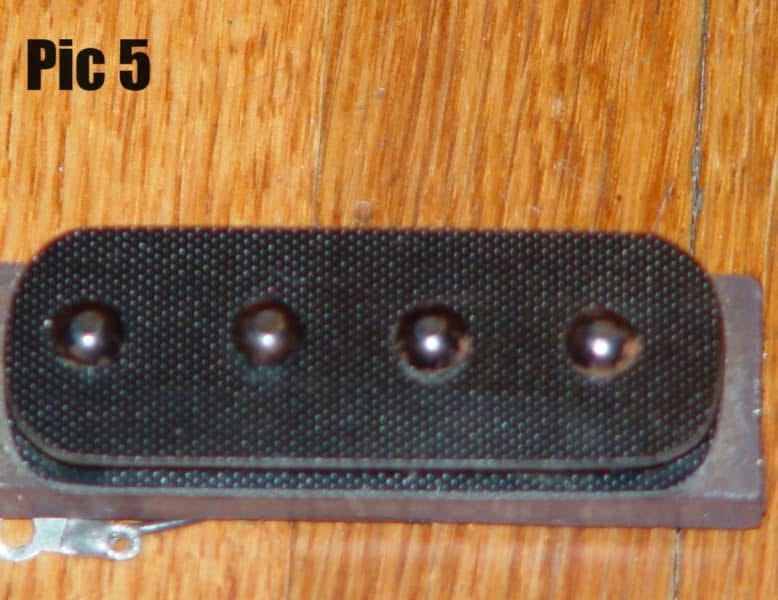
I’ve tried to nail down exactly when this change happened, but the difference in appearance is so subtle it’s hard to be certain. Every time I look at a picture and say “that one’s definitely not painted” I find a guitar made two months later where I look at the picture and say “that one definitely IS painted”. My best guess? Sometime in late 85/early 86. Please please please tell me if you know the exact date so I can correct this.
The next change is easy to spot though. In August 1991, the bobbin changed to the “dual use” molded plastic bobbin with raised “toaster” slots. Polepieces remained unpainted black button tops. John Hall said it wasn’t dual use but…c’mon. It is. Look at Pic 6. The bobbin has raised toaster slots for gods sake. But the real reason we know it’s dual use is because…
…in March 2003, shortly after “dimples” (to match the molding marks found on 63 and earlier toasters) were added to toaster pickups to help make the new C series guitars appear more authentic, Higains got dimples as well, as Pic 7 shows. Again, polepieces were unchanged with unpainted button tops.
The final (to date!) change occurred in May 2005, making the current version the longest running one. As shown in Pic 8, for the first time in its history, the Higain gained adjustable button top polepieces. Fun fact: you can remove those polepieces, screw them in from the back, and put it in a toaster case. No one will ever know!
Now there were a couple detours along the way. The 1975 430 had Higain guts inside a black plastic shell. Of course you had the BH/BT era from around 1985-2002 with era appropriate bobbins/polepieces inside black cases, and those have appeared here and there since. Lap steels wore weird screw top Higains in 1971-72. And I’m sure I’ve missed an oddball or two. But that should be more than you ever wanted to know about Higains!
One last comment that just occurred to me: ALL topmounted guitar Higains of ALL generations are mounted on foam pads, unlike the grommets found with toasters. If you find a Higain on grommets…it’s been monkeyed with.
So here’s a quick summary to help your guitar dating skills:
Late 1968-Mar/Apr 1973 (bass only): “fiberboard” bobbin with screw-top polepiece bass bridge Higain (Pics 1 & 2). May be painted black, or unpainted. Nicknames include “green bobbins” or “fiberboards”.
Early 1969-Apr/May 1973 (guitar only): painted “fiberboard” bobbin with threaded polepiece. (Pic 3). Nicknames include “first-gen” or “transitional”
Mar/Apr/May 1973-1986ish: painted “fiberboard” bobbin with painted button top polepiece. (Pic 4). Nicknames include “button top” or “fiberboard button top”.
1986ish-Aug 1991: unpainted “fiberboard” bobbin with unpainted button top polepiece. (Pic 5). Nicknames include “button top” or “fiberboard button top”.
Aug 1991-March 2003: undimpled dual use plastic bobbin with unpainted button top polepiece. (Pic 6)
March 2003-May 2005dimpled dual use plastic bobbin with unpainted button top polepiece. (Pic 7)
May 2005-present: dimpled dual use plastic bobbin with unpainted adjustable button top polepiece (Pic 8)


